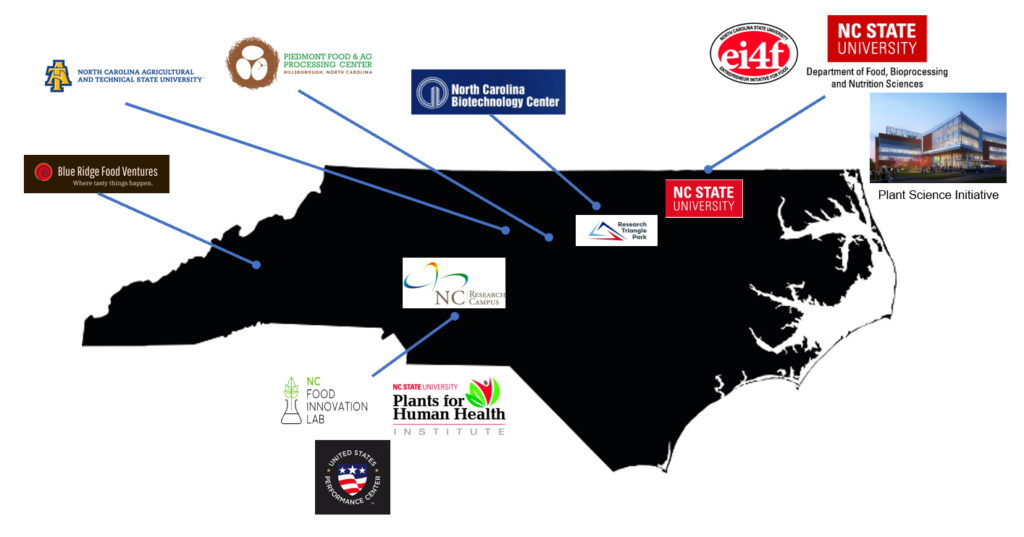The Food and Beverage Industry: Food Processing Trends

A variety of factors currently drive the food and beverage industry. Obviously, COVID-19 has impacted the industry in numerous ways, but it’s essential to consider where the industry is headed post-pandemic and how the Carolinas are positioned to support advances in food and nutrition technology.
NCFIL Executive Director Dr. Bill Aimutis did just that in his recent presentation for the Charlotte Regional Business Alliance. According to its website, the alliance is a “non-profit organization dedicated to the economic development of the Charlotte 15-county region in North and South Carolina.”
What’s Driving the Food and Beverage Industry?
In his “National and Regional Food Processing Trends” presentation, Dr. Aimutis reviewed the many factors currently driving the food and beverage industry:
- Shift in consumer consumption patterns, with a focus on healthy, plant-based foods
- Growing income inequality: as food prices increase, food insecurity also increases
- Consumer shifts in loyalty: more consumers buy local, more direct-to-consumer shopping, less big brand allegiance
- Consumer preference for transparency and a clean brand: desire for organic, natural, green, certified foods
- Consumer concern with social impact: desire for sustainability, food supporting a cause, environmental protections
- Consumer focus on safety
How Has COVID-19 Impacted the Food Industry + Consumers?
Dr. Aimutis also reviewed how COVID-19 has impacted the food industry. Some of the major effects he identified were an increase in sick farm and food production workers, slower production rates in food manufacturing plants, spot supply chain shortages and transportation system disruption. The continued spread of COVID-19 also made consumers hesitant to shop in stores or eat at restaurants.
The list of COVID-19 impacts on consumers is even lengthier, though some effects are actually positive. Consumers are practicing healthier eating habits, eating more meals at home, and committing to personalized diets and exercise. They’ve also stocked up on shelf-stable and frozen food products, done more local or online shopping, and bought foods with a social purpose. Unfortunately, there has also been an increase in food poverty.
The Food Industry Post-Pandemic?
According to Dr. Aimutis, with disruption comes opportunity. He reported on the potential changes he anticipates seeing in the food and beverage industry moving forward:
- New orientation, plant entry, health screening and social distancing standards in plants
- More robotics and automation throughout the manufacturing process
- New processes for managing future disruptions
- Re-alignment of supply chains
- Improved direct-to-consumer capabilities from food manufacturers
- Scaled-down grocery stores
- Shift in food service to offer more value to consumers
Food and Beverage Technology in NC
For innovation to occur, the infrastructure for food and beverage technology advances must be strong. North Carolina is well-positioned to meet that challenge, with 46,200 farm operations and 85-90 unique crops. It’s the second-largest U.S. state for food and beverage processing, home to 1,000+ food and beverage manufacturing establishments and 67,000 jobs. Plus, with facilities like NCFIL and others, the state stands ready to support the growing trend of plant-based diets.
NC’s Food and Beverage Industry Ecosystem
The following map identifies all the resources that support North Carolina’s food and beverage industry infrastructure.
- Blue Ridge Food Ventures
- NC A&T State University
- North Carolina Biotechnology Center
- NC State Entrepreneur Initiative for Food (ei4f)
- NC State University – Food, Bioprocessing & Nutrition Sciences Department
- NC State Plant Science Initiative
- North Carolina Research Campus, including NCFIL, Plants for Human Health Institute, United States Performance Center
- Piedmont Food Processing Center

- Categories: